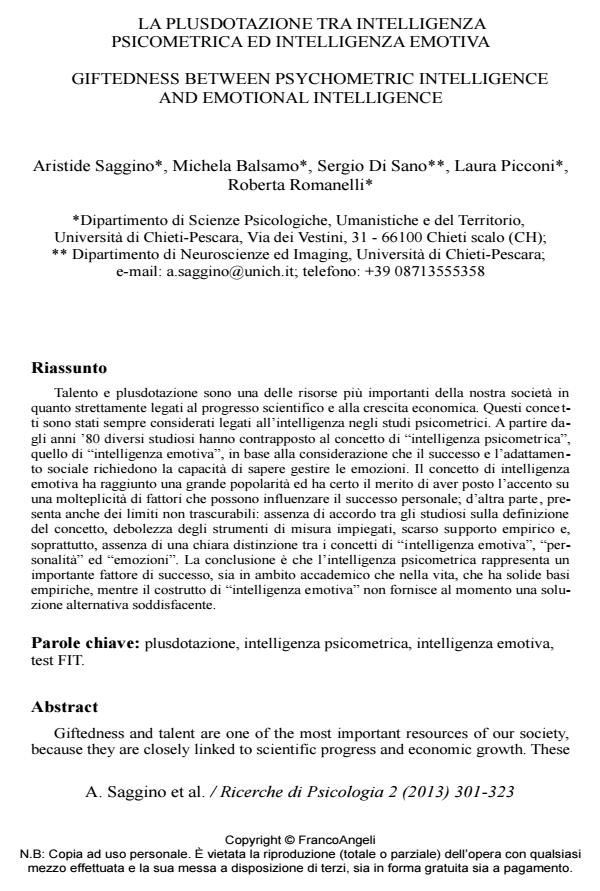La plusdotazione tra intelligenza psicometrica ed intelligenza emotiva
Titolo Rivista RICERCHE DI PSICOLOGIA
Autori/Curatori Aristide Saggino, Michela Balsamo, Sergio Di Sano, Laura Picconi, Roberta Romanelli
Anno di pubblicazione 2013 Fascicolo 2013/2
Lingua Italiano Numero pagine 23 P. 301-323 Dimensione file 240 KB
DOI 10.3280/RIP2013-002005
Il DOI è il codice a barre della proprietà intellettuale: per saperne di più
clicca qui
Qui sotto puoi vedere in anteprima la prima pagina di questo articolo.
Se questo articolo ti interessa, lo puoi acquistare (e scaricare in formato pdf) seguendo le facili indicazioni per acquistare il download credit. Acquista Download Credits per scaricare questo Articolo in formato PDF

FrancoAngeli è membro della Publishers International Linking Association, Inc (PILA)associazione indipendente e non profit per facilitare (attraverso i servizi tecnologici implementati da CrossRef.org) l’accesso degli studiosi ai contenuti digitali nelle pubblicazioni professionali e scientifiche
Talento e plusdotazione sono una delle risorse piu importanti della nostra societa in quanto strettamente legati al progresso scientifico e alla crescita economica. Questi conce tti sono stati sempre considerati legati all’intelligenza negli studi psicometrici. A partire dagli anni ’80 diversi studiosi hanno contrapposto al concetto di "intelligenza psicometrica", quello di "intelligenza emotiva", in base alla considerazione che il successo e l’adattamento sociale richiedono la capacita di sapere gestire le emozioni. Il concetto di intelligenza emotiva ha raggiunto una grande popolarita ed ha certo il merito di aver posto l’accento su una molteplicita di fattori che possono influenzare il successo personale; d’altra parte, presenta anche dei limiti non trascurabili: assenza di accordo tra gli studiosi sulla definizione del concetto, debolezza degli strumenti di misura impiegati, scarso supporto empirico e, soprattutto, assenza di una chiara distinzione tra i concetti di "intelligenza emotiva", "personalita" ed "emozioni". La conclusione e che l’intelligenza psicometrica rappresenta un importante fattore di successo, sia in ambito accademico che nella vita, che ha solide basi empiriche, mentre il costrutto di "intelligenza emotiva" non fornisce al momento una soluzione alternativa soddisfacente.
Parole chiave:Plusdotazione, intelligenza psicometrica, intelligenza emotiva, test FIT.
- The Role of Gender in the Association Among the Emotional Intelligence, Anxiety and Depression Maria Rita Sergi, Laura Picconi, Marco Tommasi, Aristide Saggino, Sjoerd J. H. Ebisch, Andrea Spoto, in Frontiers in Psychology 747702/2021
DOI: 10.3389/fpsyg.2021.747702
Aristide Saggino, Michela Balsamo, Sergio Di Sano, Laura Picconi, Roberta Romanelli, La plusdotazione tra intelligenza psicometrica ed intelligenza emotiva in "RICERCHE DI PSICOLOGIA " 2/2013, pp 301-323, DOI: 10.3280/RIP2013-002005